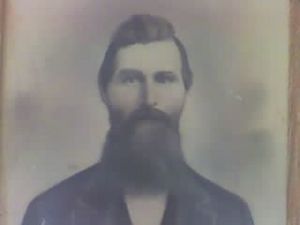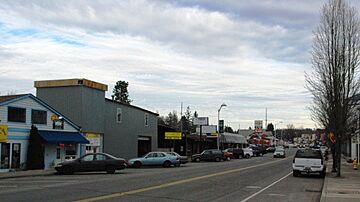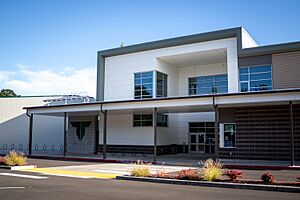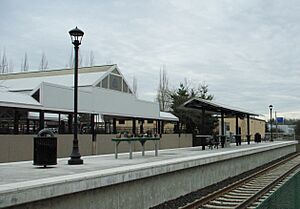Tigard, Oregon facts for kids
Quick facts for kids
Tigard, Oregon
|
||
|---|---|---|

Main Street in Downtown
|
||
|
||
| Motto(s):
A Place to Call Home
|
||
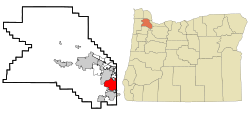
Location in Oregon
|
||
| Country | United States | |
| State | Oregon | |
| County | Washington | |
| Incorporated | 1961 | |
| Area | ||
| • Total | 12.76 sq mi (33.04 km2) | |
| • Land | 12.76 sq mi (33.03 km2) | |
| • Water | 0.00 sq mi (0.01 km2) | |
| Elevation | 240 ft (70 m) | |
| Population
(2020)
|
||
| • Total | 54,539 | |
| • Density | 4,275.89/sq mi (1,650.99/km2) | |
| Time zone | UTC-8 (Pacific) | |
| • Summer (DST) | UTC-7 (Pacific) | |
| ZIP codes |
97223, 97224, 97281
|
|
| Area code(s) | 503 and 971 | |
| FIPS code | 41-73650 | |
| GNIS feature ID | 2412069 | |
| Website | City of Tigard | |
Tigard (pronounced TY-gurd) is a city in Washington County, Oregon, in the United States. In 2020, about 54,539 people lived there. This makes it the 12th largest city in Oregon.
Tigard became an official city in 1961. It is located south of Beaverton and north of Tualatin. It is part of the larger Portland metropolitan area. The main highways that go through Tigard are Interstate 5 and Oregon Route 217. Other important roads include Oregon Route 99W and Oregon Route 210. You can get around Tigard using public buses and the WES Commuter Rail train line, which are run by TriMet.
Contents
History of Tigard
Long ago, before European settlers arrived, the Atfalati people lived in the Tualatin Valley. They had several villages where they hunted and gathered food. One village, Chachimahiyuk, was near where Tigard is today. They ate deer, camas roots, fish, berries, elk, and nuts. To help camas plants grow and keep good hunting grounds for deer and elk, the Atfalati often burned the valley floor. This was a common practice among the Kalapuya people.
The Atfalati spoke the Tualatin-Yamhill language, which was one of the Kalapuyan languages. It's believed that about 15,000 Kalapuya people lived here before they met white explorers, traders, and missionaries.
European-Americans started coming to the Atfalati homeland in the early 1800s. More settlers arrived in the 1840s. Like other Kalapuyan groups, the Atfalati faced big changes when Europeans came. By the 1830s, diseases like smallpox had greatly reduced their population. It's thought that only about 600 Atfalati people were left by 1842, and just 60 by 1848. These changes made it very difficult for the Atfalati to protect their lands.
In 1851, the Atfalati agreed to give up their lands in exchange for a small reservation and some supplies. This agreement was never officially approved. Later, in 1855, a new treaty was signed. Under this treaty, the native peoples of the Willamette Valley agreed to move to the Grand Ronde Reservation. This reservation was about sixty miles south of their original home.
The Donation Land Claim Act of 1850 encouraged many white settlers to move to the Oregon territory. Like many towns in the Willamette Valley, Tigard was settled by several families. The most important was the Tigard family, led by Wilson M. Tigard. They arrived in an area called "East Butte" in 1852. The family helped build the East Butte School, a general store (which also had the post office starting in 1886), and a meeting hall. In 1886, East Butte was renamed "Tigardville."
Between 1907 and 1910, the town grew quickly. Main Street saw new buildings like Germania Hall, which had a restaurant, grocery store, and dance hall. Telephone service also began in 1908.
In 1910, the Oregon Electric Railway arrived. This helped Main Street grow even more. Tigardville changed from a small farming community to a growing town. In 1961, it officially became a city. The railroad renamed the town "Tigard" in 1907 to make it different from nearby Wilsonville. The town's center then moved closer to the new train stop.
Electricity came to Tigard in 1911. In the 1930s, the streets of Main Street were paved. Another school was built to handle the growing number of students.
Tigard was involved in an important court case about property rights called Dolan v. City of Tigard in 1994. The Supreme Court of the United States made a decision in this case that created a new rule called "rough proportionality." This rule helps local governments decide what landowners need to do when they want to develop their property.
In 2004, Tigard voters approved a plan to add the areas around Bull Mountain to the city. However, people living in that area disagreed and have been fighting the annexation in court.
Geography of Tigard
Tigard covers about 11.69 square miles (30.28 square kilometers) of land.
Tigard Neighborhoods
The city of Tigard is officially divided into 14 areas. These areas are often named after schools or major transportation routes. Each neighborhood has a number from 1 to 13, plus the newer River Terrace area. Some neighborhoods also have older, unofficial names.
- Bull Mountain - Area 12
* Bull Mountain Park is located here.
- Cook Park (South Tigard) - Area 9
* This area is named after the park. Tigard High School is also in this neighborhood.
- Derry Dell (Central Tigard) - Area 10
* This area is south of the Jack Park neighborhoods and borders 99W.
- Downtown - Area 6
* Tigard’s city hall is here, along with the city's main downtown area.
- Durham Road - Area 7
* Named after Durham Road, this area is just north of the Cook Park/Area 9 neighborhoods and the city of Durham.
- Englewood Park - Area 2
* Named after the nearby park.
- Greenburg Road - Area 3
* This is a historic area connected to Tigard’s early days. The Washington Square Mall is located here.
- Jack Park - Area 11
* Tualatin Valley Fire & Rescue station 50 is in this area.
- Metzger (North Tigard) - Area 4
* This area covers the entire community of Metzger.
- River Terrace
* This is a large area on the western edge of the city. It became Tigard’s newest neighborhood in 2014.
- Scholls/Summerlake - Area 1
* This area borders the Jack Park/Area 11 neighborhoods and Scholls Ferry Road.
- Southview - Area 8
* This is mostly a residential area east of King City.
- Tigard Triangle - Area 5
* This area gets its name because it forms a triangle where I-5, 99W, and 217 highways meet.
- West Tigard - Area 13
* This area covers the northwest side of Bull Mountain.
People in Tigard
| Historical population | |||
|---|---|---|---|
| Census | Pop. | %± | |
| 1970 | 6,499 | — | |
| 1980 | 14,799 | 127.7% | |
| 1990 | 29,344 | 98.3% | |
| 2000 | 42,249 | 44.0% | |
| 2010 | 48,035 | 13.7% | |
| 2020 | 54,539 | 13.5% | |
| 1961 estimated pop: 1084. Sources: 1961–2000, 2010, U.S. Decennial Census 2018 Estimate |
|||
The northern part of Tigard, along with Metzger and some of Bull Mountain, uses the 97223 ZIP code for mail. The southern part of the city uses 97224, which is also used by King City and Durham. All mail for these ZIP codes is processed in Portland. The Tigard Post Office on Main Street has its own ZIP code, 97281, used only for post office boxes. Phone numbers in Tigard can have either the 503 or 971 area codes.
Tigard Population in 2010
In 2010, there were 48,035 people living in Tigard. There were 19,157 households and 12,470 families. The city had about 4,067 people per square mile.
Most people in Tigard (79.6%) were White. Other groups included 1.8% African American, 0.7% Native American, 7.2% Asian, and 0.9% Pacific Islander. About 12.7% of the population was Hispanic or Latino.
About 33.3% of households had children under 18. Most households (50.4%) were married couples living together. The average household had 2.49 people, and the average family had 3.04 people.
The average age in Tigard was 37.4 years. About 24.1% of residents were under 18, and 11.3% were 65 or older. The city's population was 49.0% male and 51.0% female.
Tigard's Economy
Several companies have their main offices in Tigard. These include Consumer Cellular, Gerber Legendary Blades, LaCie, NuScale Power, and Stash Tea Company. Tigard is also home to the Washington Square mall, which is one of the biggest malls in Oregon. The northern part of Bridgeport Village, a shopping center, is also in Tigard. Medical Teams International, a non-profit organization, is also based here.
| Employer | Employees (2014) |
|---|---|
| 1. Capital One Services | 861 |
| 2. Tigard-Tualatin School District | 779 |
| 3. Nordstrom | 422 |
| 4. Macy's Department Stores | 404 |
| 5. Oregon Public Employees Retirement System | 396 |
| 6. Costco Wholesale | 273 |
| 7. City of Tigard | 257 |
| 8. Winco | 176 |
| 9. Albertson's | 174 |
Arts and Culture in Tigard
The John Tigard House was built in 1880 by Wilson M. Tigard's son. It was saved from being torn down in the 1970s. It is now on the National Register of Historic Places and can be found at the corner of SW Canterbury Lane and SW 103rd St.
Every summer, during the Portland Rose Festival, Tigard hosts the Tigard Festival of Balloons. This event takes place at Cook Park, near Tigard High School. The tallest building in Tigard and Washington County is a 12-story building at Lincoln Center.
The Broadway Rose Theatre Company is a professional musical theater group in Tigard. They perform at their own theater, The New Stage, and at Tigard High School during the summer. The company started in 1991 and has won many awards.
The Joy Cinema and Pub is a local independent movie theater. It often shows older movies and cult films.
Education in Tigard
Most of Tigard is served by the Tigard-Tualatin School District. However, a small part of the city in the northwest is part of the Beaverton School District. The Tigard-Tualatin School District has ten elementary schools, three middle schools, and two high schools.
Schools in Tigard include:
- Tigard High School
- Fowler Middle School
- Twality Middle School
- Alberta Rider Elementary
- CF Tigard Elementary
- Durham Elementary
- Mary Woodward Elementary
- Deer Creek Elementary
- Metzger Elementary
- Templeton Elementary
The district also has an alternative school called Creekside Community High School.
Private schools in Tigard are Gaarde Christian School, Oregon Islamic Academy, and Westside Christian High School. For higher education, there are branches of Everest Institute, the University of Phoenix, and National American University. The closest traditional four-year college is Lewis & Clark College in Portland. The city also has the Tigard Public Library, which opened in 1963.
From the 1980s until 1992, the Portland Japanese School (a weekend program for Japanese citizens and Japanese Americans) was held at Twality Middle School.
Transportation in Tigard
Interstate 5 runs along the eastern side of Tigard. Oregon Route 217 starts at I-5 in Tigard. Other important roads are Oregon Route 99W, Boones Ferry Road, and Hall Boulevard. Oregon Route 210 is along the northern border, separating Tigard from Beaverton.
Public transportation is provided by TriMet. They offer several bus lines (12, 43, 45, 62, 64, 76, 78, and 94). Tigard also has the Westside Express Service (WES), which is a commuter train line. It connects Tigard to Wilsonville and Beaverton. The WES train stops at the Tigard Transit Center. The Washington Square Transit Center is the only other TriMet transit center in the city. There was a plan for a new light rail line, the Southwest Corridor light rail project. It would have connected Tigard Transit Center to the MAX Green Line by 2027, but voters did not approve the funding in November 2020.
Famous People from Tigard
- Margaret Bechard, writer
- Sammy Carlson, professional freestyle skier
- Kevin Duckworth, NBA professional basketball player
- Katherine Dunn, writer
- Mike Erickson, businessman and politician
- Johnny Frederick, professional baseball player
- Larry Galizio, politician
- Mike Kinkade, professional baseball player
- Kevin Kunnert, NBA professional basketball player
- Owen Marecic, football player
- Kaitlin Olson, actress
- Pat Whiting, politician
See also
 In Spanish: Tigard para niños
In Spanish: Tigard para niños




